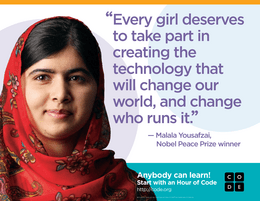The time is now to get your class signed up to join in on the
Hour of Code. December 7th through 11th. Each teacher who signs up will receive a $10 gift card. If every class in the school participates, they could be eligible for a drawing for $10,000 workd of technology.There are many options available for participating. If your students participated last year, there will be new activities for them this year. There are activities at different skill levels and
even opportunities to learn about coding in a fun and hands on way even if you don't have access to student devices in your classroom.
This summer I went to a workshop on coding and computer science put on by Code.org
code.org. I think that my biggest take away was the importance of exposure. Although there are attributes to learning coding that make it useful for all students. (Great problem solving, critical thinking, sequencing, etc.) Computer Science will not be the field that every student chooses. But, if we don't provide students the opportunity to learn and explore computer science starting at a young age, we build a generation of students who see coding and computer science as hard, and an unattainable goal. Students who have the exposure at an early age, see computer science and coding for what it is, a fun and challenging field that they might enjoy and might choose as a career choice one day.

This last year, I had a few opportunities to visit the Google offices in Seattle. I wish I could provide that opportunity for all of our students. (Except for the part where I got stuck in an elevator for over an hour.) At the Google offices, you definitely get the impression that computer science is not just for the Big Bang Theory crowd, but that computer science is just down right COOL! I would love for all of our students to have the opportunity to someday work in an environment like that. Being exposed to these skills, helps build future opportunities.

One thing that I wish I would have seen more of at the Google Campus were women working in the computer science field. And Google will tell you that they agree. We need to make sure that we are also exposing our girls to the idea of computer science as a career choice. I actually believe that Mt. Vernon, although maybe off to a late start with the Computer Science opportunities is now making great efforts to insure that our girls are welcomed and encouraged in classes and clubs for computer science.
Besides encouraging you to find a way for your students to participate, I have a challenge to you as teachers. I challenge you to participate in the Hour of Code as well. Remember, it is just an hour and you don't have to wait until December 7th to give it a try. I warn you though, that once you start, it can be hard to stop. As you "play" with coding consider what learning benefits your students will get from this activity. How can this help them be better mathematicians, communicators, artist and scientists? How can this fit in with what you are currently teaching? Which of your students might be inspired to learn more?
Learn more and register your class here.
Pin It Now!







